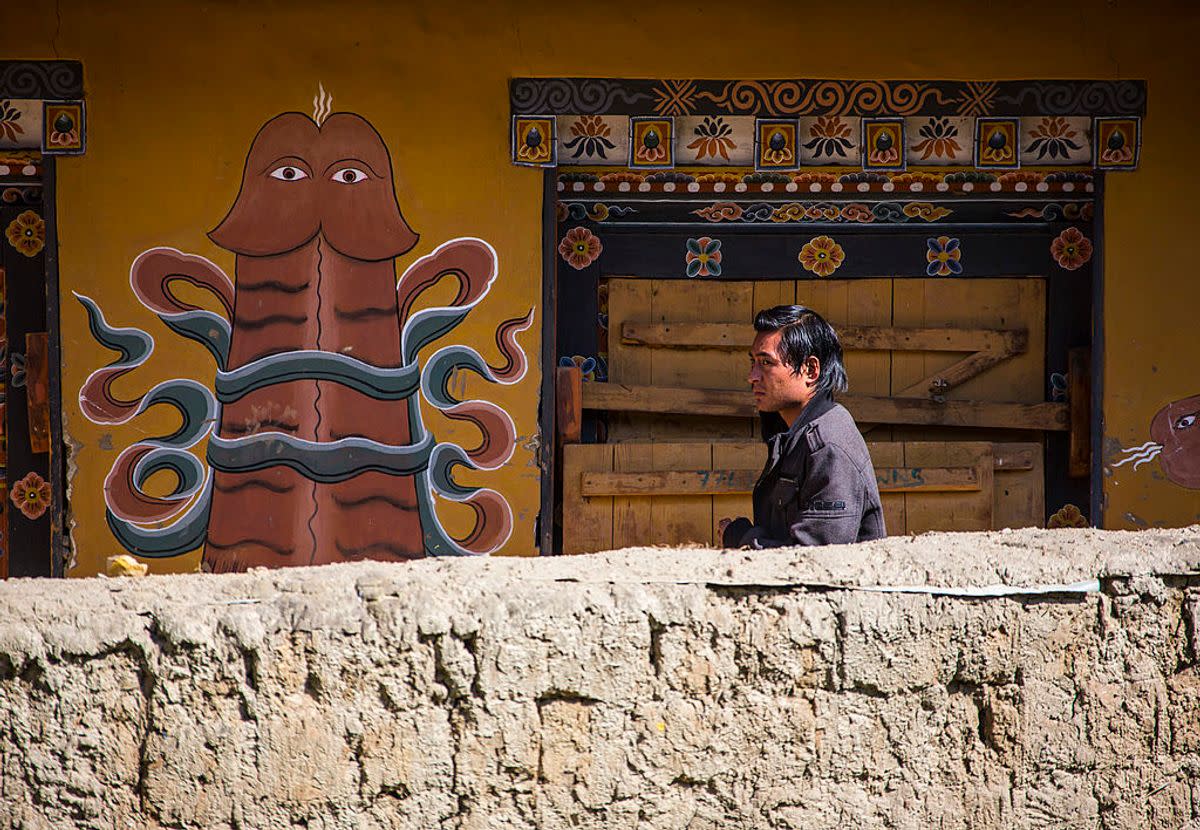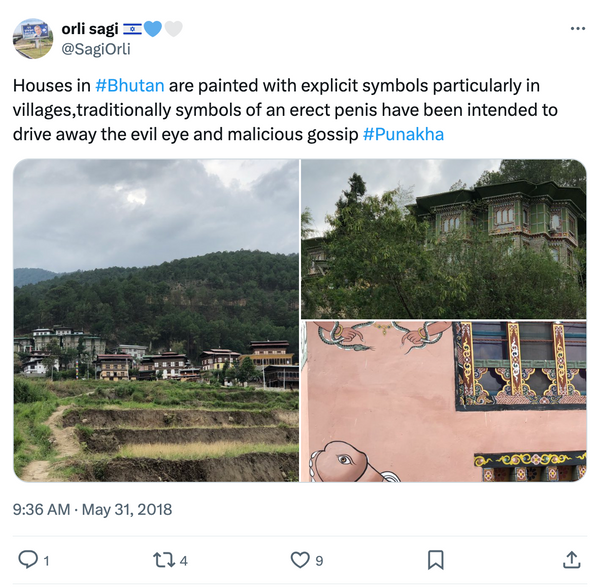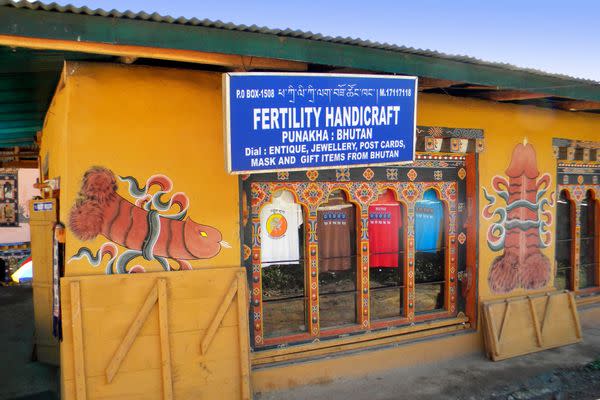Fact Check: Here's Why Locals in Bhutan Paint Phallic Symbols All Over Their Buildings

Claim:
Bhutan residents paint penises on their homes and other buildings to ward off evil and as a symbol of good luck and fertility.
Rating:
Tucked away in the Himalayas and bordered by the Tibet autonomous region to the north and India to the south, the South Asian Kingdom of Bhutan has always been a little mysterious, owing to its mountainous location, and having been open to foreign tourists only since 1974.
With 2024 marking the 50th anniversary of the Buddhist kingdom welcoming outside visitors, Snopes examined one of Bhutan's more interesting cultural tidbits — its alleged proliferation of phallic symbols painted on and affixed to buildings there.
The chatter about penises painted on buildings as a decorative feature has popped up on many Reddit posts over the years and also on X (formerly Twitter), in posts such as this one from @SagiOrli, who wrote, "Houses in #Bhutan are painted with explicit symbols particularly in villages, traditionally symbols of an erect pen*s have been intended to drive away the evil eye and malicious gossip #Punakha":

(@SagiOrli/X)
Many online commenters wondered if the phallic artwork had anything to do with pornographic or "explicit" intent. Snopes found artists have painted penises on many building façades and placed them as sculptures around Bhutan for hundreds of years, but these works of art are not intended to be obscene. Rather, they hold cultural significance deeply rooted in Bhutanese beliefs and traditions.
To get a better understanding of the phallic symbols within Bhutan, we corresponded with local guide Kinlay Gyeltshen, who is based in the kingdom and helps run Bhutan Himalayan Experience, which operates guided cultural tours and Himalayan treks in the region.
"The phallus was and still is an integral part to all rituals associated with Bon or animistic worship and beliefs," Gyeltshen told Snopes, referring to the religious practice of Bon, which predated Buddhism in the Tibetan region before spreading to Bhutan. "The phallus worship predates Buddhism, which came to Bhutan in the 8th century.
"Today, in most parts of Bhutan, the phallus is painted on homes, and wooden phalluses are hung over doors and rafters to ward off any negativity and bring about positive energy to the household and communities," Gyeltshen continued. "During the very colorful mask dance festivals, the Acharyas, or the learned masters, also carry wooden phalluses, incorporating it in their acts and dances."
Snopes also spoke to travel specialist Brent Olson, founder of ETHOS Bhutan, who has traveled to the kingdom more than 50 times since 1985.
"It's a bit shocking to most people who visit," Olson told Snopes of the phalluses. "Bhutan is a completely unique cultural entity in its own right, and they don't have the same sexual mores as perhaps the puritanical West might have."
Olson explained that the phalluses are considered a fertility symbol, while people in the villages also regard them as holy items that bring blessings and fertility to the house and also protection:
"They'll hang wooden phallic images from the corners of the roof of the eaves of the house. As a means to protect the house from evil and also to stop malicious gossip about the inhabitants of the house."
According to multiple online sources, these phallic symbols have long been associated with Drukpa Kunley, a revered Tibetan Buddhist monk known as the "Divine Madman," who is believed to have helped popularize them in Bhutan when he arrived in the late 1400s.
Local legend tells the story of Drukpa Kunley, also known as the "the Saint of 5,000 women," who was renowned for his unorthodox teachings and unbridled antics, using humor and shock value to spread Buddhist teachings. As part of his teachings, he employed phallic symbols as a representation of fertility and spiritual protection, warding off evil spirits.
Olson explained that within a segment of Buddhism there are "teachers called divine madmen, who are enlightened beings who can use any method at their disposal to help people achieve enlightenment."
As the story goes, Drukpa Kunley subdued the demoness Loro Duem, who was terrorizing locals, by transforming her into a dog, using his "flaming thunderbolt of wisdom" (i.e., his phallus) to pacify her. Following this, he is said to have engaged in various unconventional acts, including intimate relations with women and using his phallus as a spiritual weapon.
Of Drukpa Kunley's "flaming thunderbolt of wisdom," Olson said, "He used that as a way to shock people out of their complacency about being stoically Buddhist and just thinking that that represents the good aspects of Buddhism, whereas showing that sexuality and the phallic image is all part of Buddhism. It just depends on your understanding of the illusion of duality, where you separate things into good and bad or right and wrong. And so by using the phallic image as a powerful, religious symbol, it sort of helps to deflate the righteousness and the ego of the religious officials as well."
It is believed that Drukpa Kunley blessed the monastery and temple of Chimi Lhakhang with his spiritual presence during his travels through Bhutan. Per Taste of Bhutan:
The legend says Drukpa Kunley launched an arrow from Tibet to identify a new location where he could propagate his Buddhist teachings. The arrow fell near the current site of Chimi Lhakhang in Punakha (where his temple now stands) and guided him to Bhutan. During the search for the arrow, he met a young woman who believed in his cause. He spent the night with the woman and 'blessed' her with his offspring. The location of the Chimi Lhakhang is perceived as sacred and now houses an ancient bow and arrow as well as a 10-inch ivory and wood phallic emblem.

( Getty Images)
Also referred to as the "temple of the divine madman," Chimi Lhakhang, built in 1499, still stands today in the Punakha District in the northwest of the country, and became known as the "temple of fertility."
Mukesh Gupta — an Indian national originally from Darjeeling who is now based in California — has operated Bhutan Travel since the 1980s. Owing to the relaxed border controls between the northeast Indian state of Sikkim, where Darjeeling is located, and Bhutan, Gupta has been crossing the border into Bhutan since before the kingdom was officially opened to tourism in 1974.
Gupta said he has been chaperoning Western tourists to Bhutan for decades, and owing to his steeped history as a regular visitor to the region, he can understand the perspective of Westerners when they first see the abundance of Bhutanese phalluses:
I've been dealing with Western tourists ever since my school days. I know their perspective and their thinking and how a Westerner or an outsider looks at these sorts of things, so I can see from both sides. In Bhutan, the locals don't see any contradiction. They just do whatever their father's forefathers did, they just follow tradition. They don't want to go against the tradition. So it's more of a cultural tradition and obviously nowadays less of a religious thing. In fact, it's no longer a religion thing at all. The phalluses and symbols and pictures and drawings, you will not find in real temples. These phalluses are mostly found in private homes. Sometimes, the only temple you'll find them in is the temple that was set up to honor the "madman," because the phalluses and symbols are dedicated to him.
Gupta added that while some locals may decry the commercialization of the phallic symbols, they do appreciate that it's something tourists like to purchase and bring home as a keepsake of their time in Bhutan, adding that he has "two in my office here" at his home north of Los Angeles.
Echoing what Olson told Snopes, Gupta noted the Bhutanese tradition of having the phalluses placed at the four corners of the roof of a home, which is still done today with newly built dwellings. "That's what I like about Bhutan, they still continue to follow tradition — not only this, but all other traditions. Now [placing the phalluses on the eaves] is more of a fun thing to do, which is also tradition and culture."
Gupta also discussed the custom of young men and women in Bhutan taking part in a fake "fight while hanging those penises" with the rope. "The men try to raise it up," he explained. "The girls try to pull it down with the rope. And that's sort of like a game. It has become traditional over the years and centuries. That has become a game. And always traditionally, the girls win. It's more like a flirting game for people to get to know each other. It's definitely not religious, but that's part of the process they do to build a new home. And then after, the boys invite the girls to drink and merriment."
The phallic symbols adorning Chimi Lhakhang's walls continue to be venerated by locals and visitors alike. Each year, people flock to the temple from all over the world to offer prayers, particularly as they relate to conception, and to receive fertility blessings. According to Daily Bhutan, the fertility blessing performed at the temple goes like this:
Women who visit this Buddhist monastery seeking blessings to conceive will first be hit on the head with a 10 inch phallus made of wood and ivory by a presiding Lama. This is followed by being hit by a bow and arrow which was purportedly used by the Divine Madman – Drukpa Kuenley himself hundreds of years ago.
Following this part of the ceremony, the women are then purportedly made to walk around the temple three times while carrying the wooden phallus. Many miracle babies are said to have been born following their parents' visit to the temple for fertility blessings. These miracle babies are sometimes named Chimi/Chime, which means "no dog," or Kinley, which translates to "kind-hearted."

( Getty Images)
Today, phallic symbols are ubiquitous in Bhutan in the form of souvenirs catering to local traditions and tourist interests. These pen*s-adorned trinkets range from traditional wooden and stone carvings and textiles, prayer wheels and jewelry, to more modern items like keychains, magnets and paperweights. Phallic souvenirs remain popular among tourists, blending tradition with modernity in the country's evolving cultural landscape. According to Gupta, you can even find phalluses for sale "made out of leather with pubic hairs, which are made out of yak."
Gupta explained that while phalluses are no longer seen on newer government buildings and universities, "because the government does not want to be associated so much with this kind of tradition, because now they're trying to Westernize a little bit," distinctive paintings of penises that tell a story can still be seen on private homes.
"Lots of idiosyncratic pictures will come up, depending upon who the painter is and what he or she is thinking," Gupta said. "They now have penises with eyes, penises with wings — this is not regular eyes, but cosmic eyes, things like that. So they'll have pictures of penises with wings and then that becomes some flying penises like the tigress who flew Padmasambhava, the great Tibetan monk, to spread Buddhism into Bhutan."
Aside from the phallic symbols, Bhutan is known for its unique Gross National Happiness Index, which prioritizes the well-being and happiness of its citizens over purely economic measures. The presence of penises in Bhutan's cultural landscape is a reflection of the country's rich and vibrant heritage, which values spirituality, tradition and happiness above all else.
So, as it turns out, the practice of painting penises on buildings and placing phallic sculptures in Bhutan is not only true, it's widespread and is considered a form of spiritual protection and a way to promote harmony and prosperity in communities, while also bringing good luck and fortune. Snopes has previously written about phallic symbols in the natural world and also in other parts of the world.
Sources:
"Bhutan Travel - The Oldest & The Most Knowledgeable." Bhutan Travel, https://bhutantravel.com/. Accessed 21 Mar. 2024.
"Bhutan Travel, Treks and Cultural Tours." Bhutan Himalayan Experience, https://bhutanhimalayanexperience.com/. Accessed 21 Mar. 2024.
Bhutan – Gross National Happiness Index : Wellbeing Economy Alliance. http://weall.org/resource/bhutan-gross-national-happiness-index. Accessed 18 Mar. 2024.
Chimi Lhakhang | The Fertility Temple | andBeyond. https://www.andbeyond.com/experiences/asia/bhutan/punakha/chimi-lhakhang-fertility-temple/. Accessed 18 Mar. 2024.
"ETHOS Bhutan." ETHOS Bhutan, https://ethosbhutan.com. Accessed 18 Mar. 2024.
"How And Why Bhutan Came To Worship The Phallus." Culture Trip, 15 Mar. 2018, https://theculturetrip.com/asia/bhutan/articles/how-and-why-bhutan-came-to-worship-the-phallus.
"Https://Twitter.Com/SagiOrli/Status/1002227330104807425." X (Formerly Twitter), https://twitter.com/SagiOrli/status/1002227330104807425. Accessed 15 Mar. 2024.
Modern Miracles. https://www.chimilhakhang.com/modern-miracles. Accessed 18 Mar. 2024.
Nast, Condé. "Why This Bhutan Town Has Phalluses Everywhere." Condé Nast Traveller India, 21 Mar. 2016, https://www.cntraveller.in/story/why-this-bhutan-town-has-phalluses-everywhere/.
Pray to Conceive at the Chimi Lhakhang. http://www.dailybhutan.com/article/pray-to-conceive-at-the-chimi-lhakhang. Accessed 18 Mar. 2024.
Rahman, S. M. Mamunur. "Why Bhutanese People Paint Erect-Penis on Their Homes." The Masterpiece, 23 Aug. 2021, https://medium.com/the-masterpiece/why-bhutanese-people-paint-erect-penis-on-their-homes-a360a46310ba.
tashic. Visit Bhutan – Permanent Mission of Bhutan to the United Nations. https://www.mfa.gov.bt/pmbg/visit-bhutan/. Accessed 15 Mar. 2024.
tasteofbhutan. "The Phallus of Bhutan and Its Unique Meaning." Taste of Bhutan, 1 Dec. 2021, https://tasteofbhutan.com/the-phallus-of-bhutan-and-its-unique-meaning/.
"Why This Small Country Has a Penis on Every Roof." MEL Magazine, 3 Mar. 2021, https://melmagazine.com/en-us/story/bhutan-phallic-art-drukpa-kunley.


